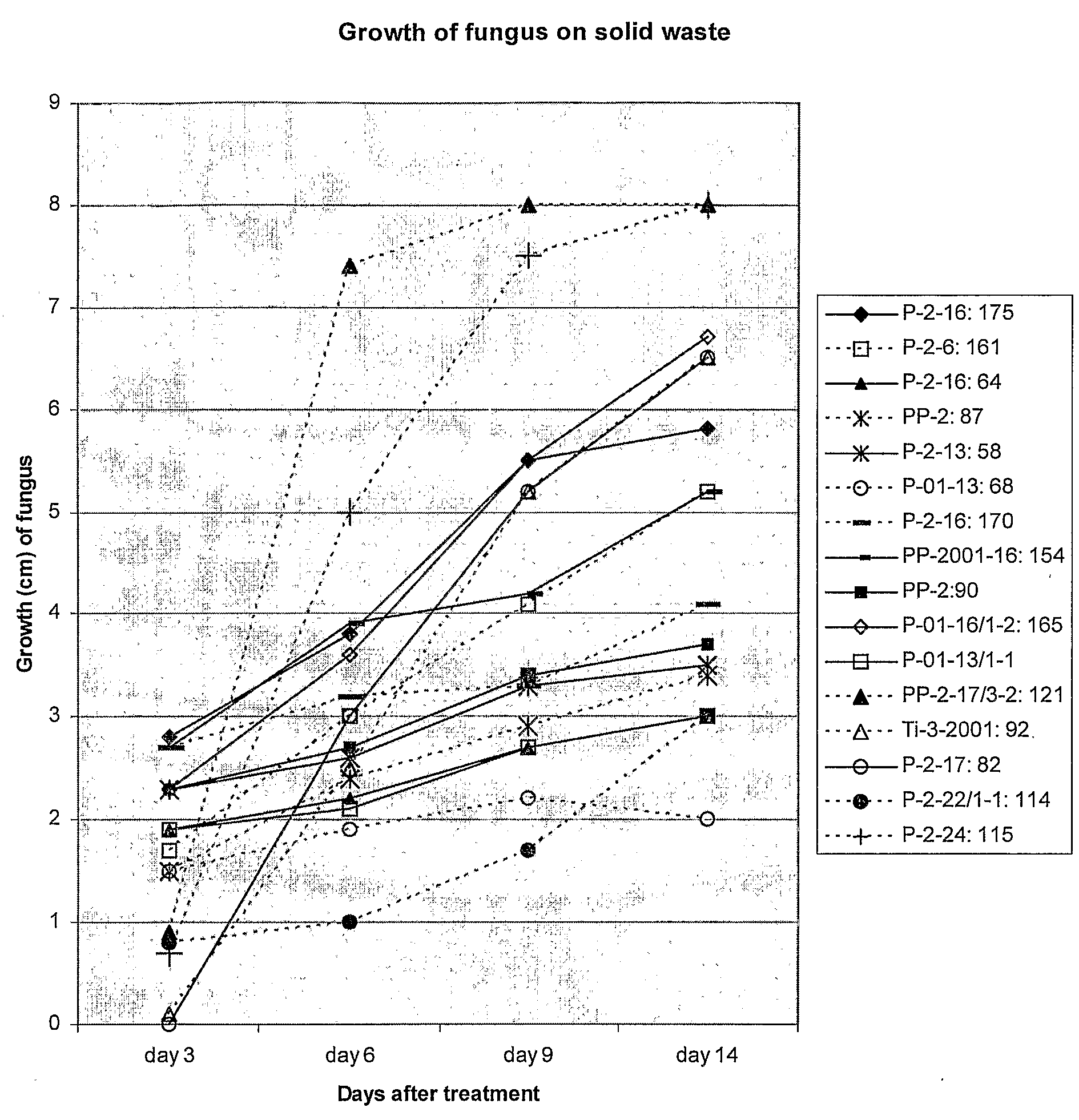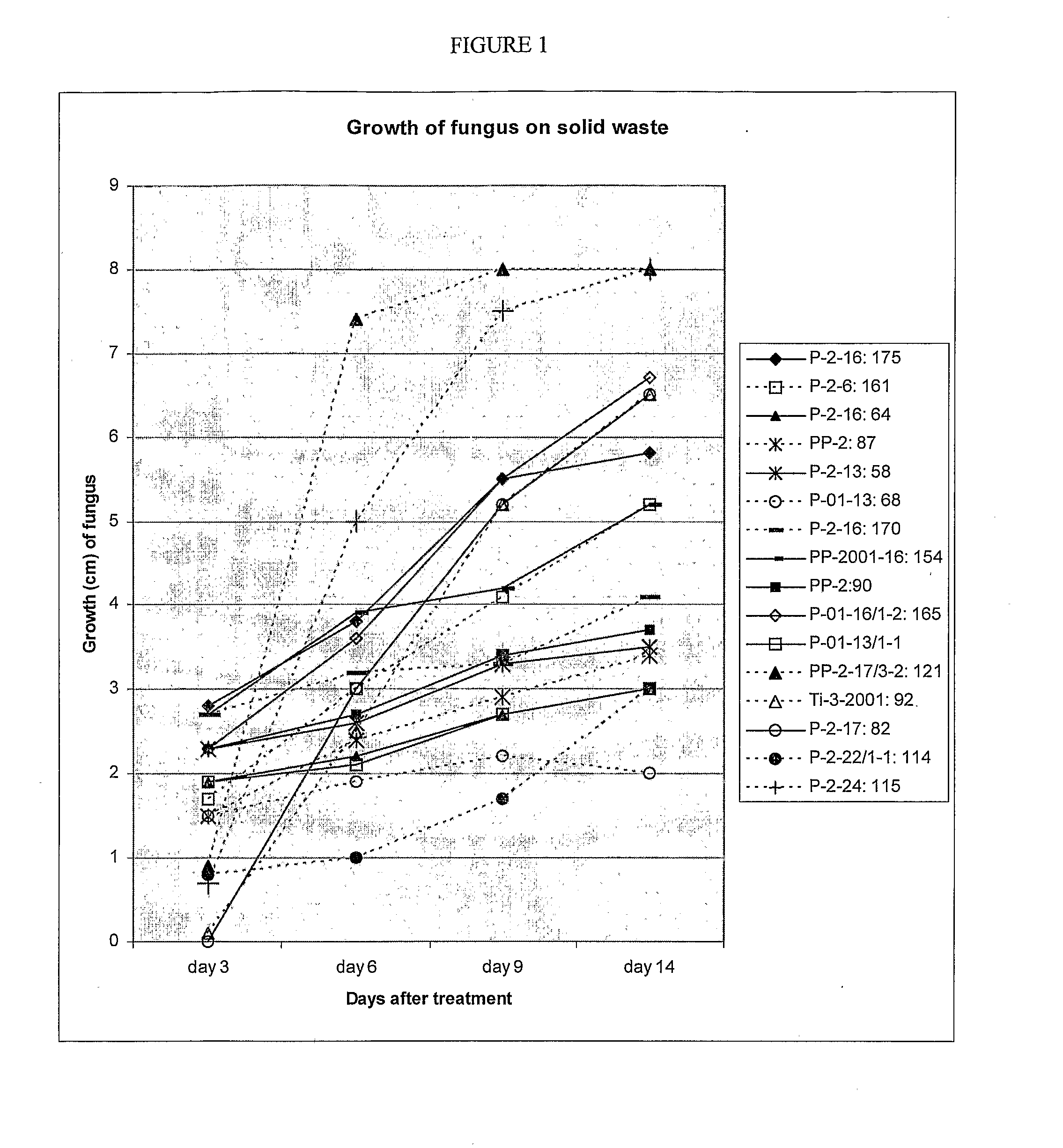Method of using endophytic fungi to decontaminate and decompose human and animal wastes
a technology of endophytic fungi and human waste, which is applied in the direction of biological water/sewage treatment, drug compositions, products, etc., can solve the problems of untreated residues and human health threats, and achieve safe and rapid decontamination of human wastes, easy digestion of carbon, and effective treatment of human solid and liquid wastes
- Summary
- Abstract
- Description
- Claims
- Application Information
AI Technical Summary
Benefits of technology
Problems solved by technology
Method used
Image
Examples
example 1
[0027]Initial Screening for Endophytic Fungi Growing in the Presence of M. albus.
[0028]The purpose of this experiment was to find a non-pathogenic, endophytic fungus that will decompose waste in the biodegradable WAG BAG® in the presence of M. albus. The WAG BAG® is a commercially available product of Phillips Environmental Products, Inc. (“Phillips Environmental Products”). The WAG BAG® is a disposal kit for human waste that contains a blend of a super-absorbent polymer (preferably, sodium polyacrylate), a deodorizer (preferably, zeolite), and a decay catalyst (preferably, catalytic yeast enzymes) in a 1.5 mil thick waste collection bag, which in turn is packaged in a 2 mil thick outer bag. The absorbent stabilizes the contents of the WAG BAG® for safe transportability, and the deodorizer provides instant odor reduction. The WAG BAG® also includes a 3 mil thick disposal bag, towelette, and toilet paper. All three bags that make up the WAG BAG® are made out of a biodegradable linea...
example 2
[0032]Fungal Growth on Solid Waste.
[0033]Test fungi demonstrating the ability to grow in the presence of M. albus were grown on PDA for seven days in order to develop an inoculum base for testing on solid human waste. For each test fungus, 1 g of fresh solid waste from a healthy 22-year-old female was placed in the center of a Petri plate. A test fungus was obtained by cutting the mycelium on the agar cut into small cubes (½×½× 1 / 2 cm3) using sterile techniques and then placing it on top of the solid human waste dollop (about 1 gram). Data were collected over a 14-day period regarding the diameter growth of each test fungus, the degree of bacteria growth, and the attractiveness of the fungus toward the waste dollop (see Example 3 below for an explanation of how “attractiveness” was measured). As shown in FIG. 1, each of the fungi tested showed growth on the dollop of human waste; however, the fungi P-2-16:64 and P-2-24:115 showed the best mycelial growth. The other fungi clustered ...
example 3
[0035]Ability to Inhibit Bacterial Growth.
[0036]Because bacteria are the main microbial and most harmful constituents of human solid wastes, 16 of the 20 endophytic fungi were then tested for their ability to inhibit bacterial growth. The degree of bacterial growth was measured visually by:−(lots of bacterial growth), +−(some bacterial growth), +(slight bacterial growth), and ++(no bacterial growth). In addition, the degree of attractiveness of the individual fungus towards the dollop was measured visually by: −(growth away from dollop), +−(slight growth towards dollop), +(attachment to dollop), ++(growth covering dollop). Data were assessed after 14 days. As shown in Table 1 below, in many cases bacterial growth was rampant in the presence of the endophytic fungus (see, for example, P-2-16:175); however, the fungus P-01-13 / 1-1:32 precluded all observable bacterial growth. The fungi having a single +(inhibition of most bacterial growth) were represented by such fungi as P-2002-16:15...
PUM
| Property | Measurement | Unit |
|---|---|---|
| thick | aaaaa | aaaaa |
| thick | aaaaa | aaaaa |
| thick | aaaaa | aaaaa |
Abstract
Description
Claims
Application Information
 Login to View More
Login to View More - R&D
- Intellectual Property
- Life Sciences
- Materials
- Tech Scout
- Unparalleled Data Quality
- Higher Quality Content
- 60% Fewer Hallucinations
Browse by: Latest US Patents, China's latest patents, Technical Efficacy Thesaurus, Application Domain, Technology Topic, Popular Technical Reports.
© 2025 PatSnap. All rights reserved.Legal|Privacy policy|Modern Slavery Act Transparency Statement|Sitemap|About US| Contact US: help@patsnap.com



